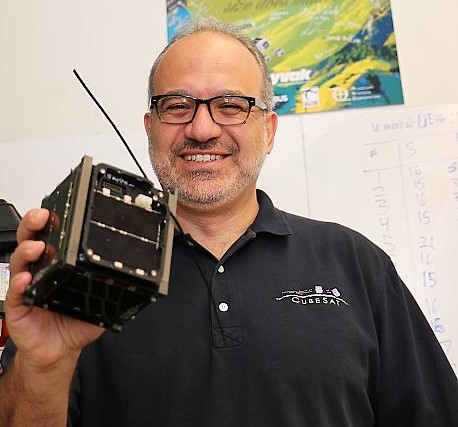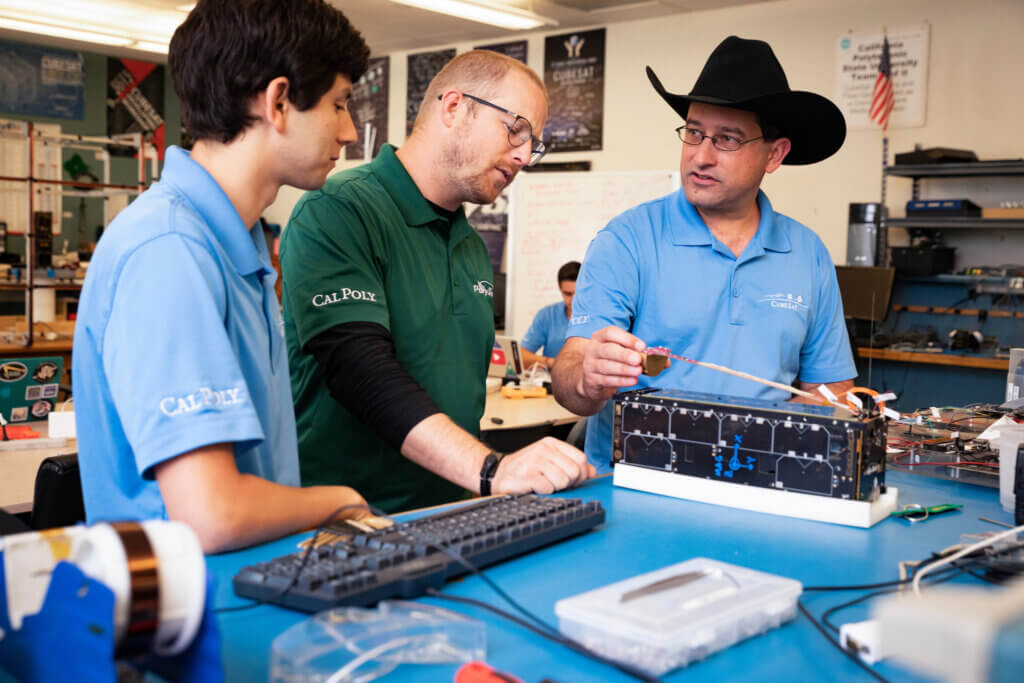
The key to understanding the wide-ranging influence of CubeSats, said co-creator Jordi Puig-Suari, is to think of the mini-satellites as the sandbox where the industry learned how to do space in a different way.
“Faster, smaller, taking more risk and leveraging the technological developments of non-space industries, such as the commercial electronics sector,” said Puig-Suari, a retired Cal Poly aerospace engineering professor. “Those new ways of doing business that were introduced by CubeSats form the basis of many of the new missions being developed by space companies.”
The CubeSat design standard, which he created with now-retired Stanford University professor Bob Twiggs, will be inducted into the Space Technology Hall of Fame. The Space Foundation will bestow the honor during the 37th Space Symposium in Colorado Springs April 4-7.
Puig-Suari and Twiggs created the CubeSat – a satellite the size of a bread loaf – as a teaching tool in 1999. Initially intended to give students experience in satellite functionality, the standardization of the invention made it relatively simple and affordable for other schools, governments and private organizations to create satellites that could be launched into space and used for research.
“Not only have thousands of students from all over the world been able to launch a satellite, it has turned into a billion-dollar industry and has played a major part in bringing about a renewed enthusiasm about space that hasn’t been there since the Moon landing,” said Ryan Nugent, director of the Cal Poly CubeSat Lab.
Prior to the CubeSat, satellites were massive creations that were expensive to launch. As a result, only a few space organizations could create them. Since then, CubeSats have become a regular feature of important space missions and developments, including the recent Mars Insight rover and the Planetary Society’s LightSail projects. CubeSats are also regularly launched from the International Space Station.
And it all began with Cal Poly.
“Any discussion of the evolution of CubeSats should include Cal Poly’s prominent role,” said John Bellardo, a computer science professor and faculty advisor to the program.
The induction from the Space Foundation, whose leadership includes a former NASA astronaut and several space industry executives, does just that – and more.
“This distinction is also a validation of the idea that the ‘traditional’ way or doing things’ isn’t always the best and can be an inhibitor to innovation, which we hope to continue as we strive to provide our students with hands-on experience with cutting-edge space technologies,” said Nugent, who worked on CubeSats when he was both an undergraduate and graduate student at Cal Poly.
Last year, a CubeSat launched on a Virgin Orbit rocket was the 12th mini satellite designed, assembled and tested at Cal Poly that has been launched into space. One of the current CubeSat projects will look at a new radiator technology.

“The radiators are a critical component of spacecraft because they allow waste heat to be rejected from the vehicle, a necessary process for both higher-powered missions and missions that operate in a hotter environment for an extended period of time,” Bellardo said.
Helping future missions, an upcoming partnership with the Air Force Research Laboratory will provide access to newer equipment, facility upgrades and experts in the field.
“While we proudly claim a major role in the advent of the CubeSat, we want to remain relevant with this important technology,” said Associate Dean Eric Mehiel, an Aerospace Engineering faculty member who plans to attend the induction ceremony with Puig-Suari. “This partnership will help Cal Poly continue to push CubeSat innovation well into the future.”
While Puig-Suari was singled out in the Space Symposium release about this year’s three Hall of Fame inductees, he was quick to note the support the program had from the university’s administration and the Cal Poly Corporation, which helped navigate significant legal and regulatory obstacles that the first Cal Poly CubeSat launch, in Russia, required.
“I feel that this high-level effort reflects the commitment of the university to facilitate activities that enhance the educational experience of the students,” he said.
And, eventually, those efforts allowed space research and exploration to proliferate, making CubeSats a regular feature of space industry news.
“It is a little overwhelming to think that a lot of these new developments in the space industry are ‘my fault,’” Puig-Suari said. “When we started, we never expected to have such a significant effect. At this point, I am very proud of what we accomplished and to be able to say that I helped change the world for the better.”


